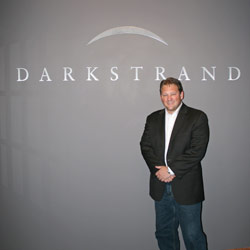Dark Fiber Jumpstarting Innovation

It’s a classic story of entrepreneurial innovation—a business need, unaddressed by the marketplace, becomes an opportunity for the right person with the right vision. And that was the beginning of Darkstrand.
Speed is a quintessential function of many successful businesses—especially in the technology field. Any business owner will tell you that the faster a product or service can be developed and get to market will have a direct correlation with their chances for success. Michael Stein and his start-up company, Darkstrand, are trying to leverage that very philosophy.
“I tell our investors all the time—I didn’t go into this to start a company; I went to solve a business need,” said Stein, president and CEO of Peoria-based Darkstrand. “That’s where the best business plans lie. America has these wonderful tools that are not being pushed to the marketplace quickly enough. And it’s at the heart of our American competitive advantage.”
Stein, a lifelong Illinois resident, has been a part of the information technology industry for nearly 20 years. A true entrepreneur, he is trying to capitalize on a network of in-ground fiber called the National LambdaRail (NLR), a 12,000-mile optical network that connects U.S. universities and research institutions and is utilized for massive, data-intensive project work for NASA, the Department of Defense and the scientific community. The most powerful research backbone in the country—and the only one of its kind on the planet—is not theoretical, it is fully operational. And Darkstrand is the company responsible for making it available for commercial use.
“We look at this as a very powerful tool to build products,” said Stein. “In conjunction with the labs we’re connected to, which is a unique feature of the [NLR], you can use high-performance computing and high-speed networking to shave off a lot of time to market.”
Stein and his partners, with the backing of advisors like former Caterpillar CEO Glen Barton, RLI President Jonathan Michael and former Monsanto CEO Robert Shapiro, are trying to help Fortune 500 companies and Hollywood studios tap into the capabilities of the NLR to bring product innovation to the market more quickly and efficiently.
In the spring of 2008, Darkstrand purchased half of the capacity of the NLR, becoming the exclusive company to commercialize the network. It is in the beginning stages of negotiating with potential users, which, according to Stein, includes a major insurance firm and several movie studios, for starters. Rather than being their own network providers, these companies would purchase access to the NLR, which will facilitate advances that only supercomputing can support—allowing companies to focus on their core business while saving money and producing at a rate never seen before.
“I describe it to our customers as the physical network to these [research] labs that you’ve never had,” explained Stein. He understands that there are people out there sitting in cubicles, with million-dollar ideas but no way to capitalize on them without the necessary tools. By connecting them to the NLR, Stein envisions a path to jumpstarting innovation on a massive level.
In addition to bandwidth, Darkstrand helps companies through the process and shows them how to utilize the NLR’s capabilities. “We’re also the human network,” says Stein. “We have a consulting layer and can help manage that engagement [with research facilities]. We will work with you to help manage the process.
“We have incredibly smart people in the research community that know how to utilize these tools. We need to get corporations interacting with them on a much larger level than they are today. If that happens, a lot of the bad news we’re watching on TV right now could go away…” A Need Presents Itself
A Need Presents Itself
“My first real job out of college was in the CAD/CAM world,” recalled Stein. “Early on, I got a good lesson in how technology affects companies and product development. I really got an eye-opening to what the research community had in terms of tools that I didn’t see in corporate America.”
Stein eventually became vice president of BOS Systemhaus, a high-level engineering firm located in Switzerland that provides technology solutions for companies like Caterpillar, BMW, Motorola and John Deere. He left BOS to join Digital Kitchen (DK), a film production and motion graphics company that won several Emmy awards for its work on the HBO series Six Feet Under. At DK, he was chief architect of business expansion, building the company’s strategic direction and customer base.
During his time at BOS and DK, Stein discovered that there was no process that allowed for moving massive data files across networks with the necessary speed. While searching for a solution, Stein discovered that other production companies struggled with the same issues.
After researching the problem and talking to networking experts, he discovered that the technology was in fact available, but there was no commercial mechanism for its use. “The birth of Darkstrand was going back to some of these research facilities and saying, ‘How do I get access to these tools?’” explained Stein. “I didn’t actually go into it looking to start a company—I wanted to use the tools,” said Stein. The lack of a clear path to use these tools led to the creation of Darkstrand.
Accessing the LambdaRail
Stein formed the company in 2005 and spent the next several years lining up investors and laying the groundwork for the purchase of access to the NLR. The original business model, however, did not include the NLR—Stein was going to develop his own network.
“It was going to be a boutique, virtual private network,” he said. “We had a solution in mind…and took that to the research company and said, ‘Okay, let’s build this.’ That’s when they alerted us to the LambdaRail.”
Not just anyone could bid on access to the NLR. Fortunately, Darkstrand had spent the two years leading up to its pitch for access by developing its idea with the right people in the research community. Most of the competition just wanted access, but Stein’s vision went further. It wasn’t just about who would pay the most, according to Stein, it was also about who would develop and ensure that the network is used to its fullest capabilities.
“Our business model won it,” said Stein. “We want to use this capacity to fix what we believe is a very significant problem in corporate America’s time to market. When you sum up Darkstrand in an elevator pitch, that’s what we’re trying to do: shorten the time to market by utilizing these next-generation tools.”
Stein believes that Darkstrand’s service is potentially revolutionary, bridging the gap between research and commercialization and allowing its users to utilize network and supercomputing capabilities that were previously out of reach. That means that a company like Caterpillar or General Motors could design tractors or cars more quickly; Disney could make animated films more cheaply.
“We want to be a solutions provider for corporations,” said Stein. “We have a great asset that you can use to do exactly what you want to do. Our real win…is when we go and do something for a corporation today that they couldn’t do yesterday. These tools allow that,” Stein said.
Meanwhile, a small buzz is being generated. Darkstrand has been featured in the pages of BusinessWeek and other publications, and Stein is already in talks with companies wanting to plug into the capabilities of the NLR. “We won the contract, which stunned a lot of people,” he said. “We popped up on the radar much [more quickly] than we wanted to. We were not even going to launch until later in the year.”
With the backing of so many intelligent and connected people, it would seem that Darkstrand is on solid footing. While the credit crunch has made for a more challenging environment, the business model remains strong. It is American innovation that will lead our way out of this recession, and Darkstrand can help facilitate this. iBi

